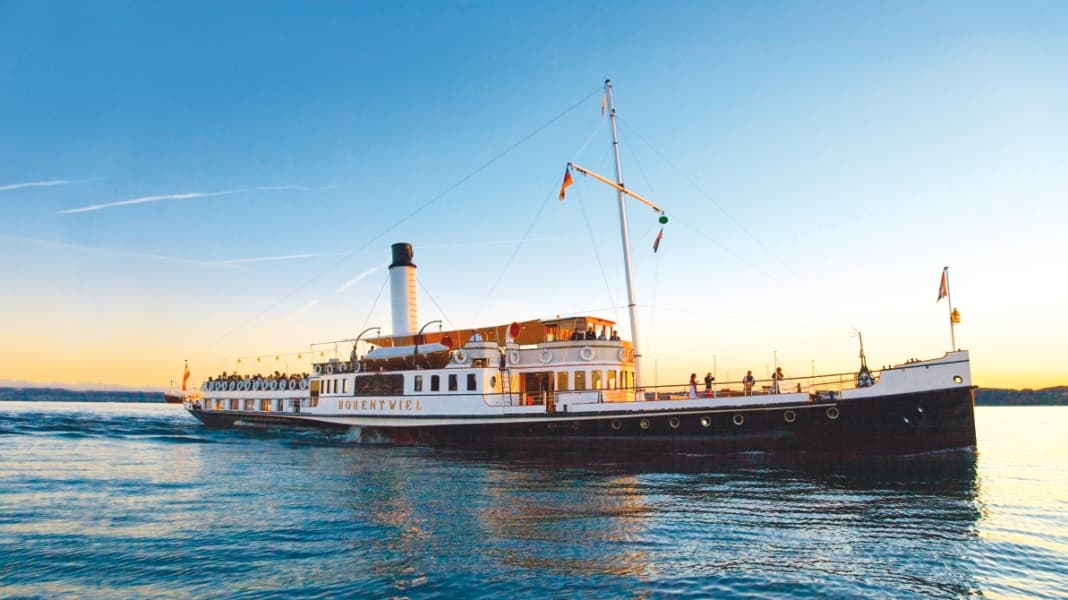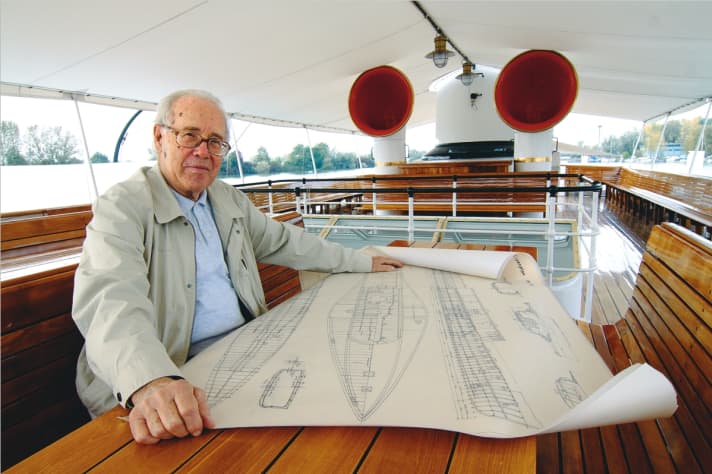Lake Constance steamer Hohentwiel - Time travel on the paddle steamer Hohentwiel
Hildegard Nagler
· 06.05.2016

She steams majestically and gracefully through her second life, unperturbed by anything or anyone. A noble paddle steamer whose chimney can be seen from afar, in the middle of the deep blue waters of Lake Constance, with thousands of stars dancing on the crests of the waves and a magnificent view of the mountains: with its almost unbelievable beauty in a dreamlike setting, the 102-year-old "Hohentwiel" captivates and fascinates crowds of people - just as the paddle steamer, built by Escher Wyss & Cie in Zurich for King Wilhelm II of Württemberg, did in its first life.
Today, hardly anyone can believe that the end of the ship seemed sealed in the 1980s after many years of hard work on Lake Constance - it was only thanks to the courage and commitment of a group of people that the last paddle steamer on the Swabian Sea was saved in a cross-border, nerve-wracking operation and given a second life 25 years ago.
Back to the future: a trip on the "Hohentwiel" is a fascinating journey through time






But first things first. On 3 May 1911, the General Directorate of the Royal Württemberg State Railways approved the construction of a new ship to be named "Hohentwiel" in honour of the basalt cone rising 689 metres above Singen in Hegau. It is to be a semi-saloon steamer like its sister ship "Friedrichshafen", built in 1909; the stern saloon will be lowered into the rear part of the hull. The ship's height above water would thus be lower, which in turn would reduce the area exposed to the wind in the very unpredictable wind conditions on Lake Constance. The ship cost 325,000 marks to build, with the saloon furnishings costing an additional 15,000 marks. The costing books are carefully kept in Zurich: Two thick hand-written and hand-drawn tomes still tell the story today.
Part after part is transported from Zurich in open goods wagons to Romanshorn, where it is sailed across the lake in traction barges and moved onto the dockyard track in Friedrichshafen. 100 workers rivet the steamer together. Clients and shipbuilders reacted to the "Titanic" disaster: The hull for the new ship is divided into seven watertight sections so that the steamer is still buoyant even if water has penetrated one compartment.
On 1 May 1913, the "Hohentwiel" is officially put into service with a crew of eight men. Things are fine on board - as is tradition, the Württembergers have recruited crew members from the imperial navy. Count Ferdinand von Zeppelin, for example, celebrates his 75th birthday together with the royal family and his staff on the "Hohentwiel" on 8 July 1913. On 12 August of the same year, King Friedrich August III of Saxony spent several hours on a tour of Lake Constance on the "Hohentwiel" at the invitation of the Württemberg monarch.
The "Hohentwiel" runs out of steam at the Seenachtsfest in 1962
Only a few people realise what it looks like "underneath": At 60 degrees Celsius below deck, the two stokers shovel coal into the flame tubes - 6.5 tonnes on one trip from Bregenz to Constance alone. The working day on the "Hohentwiel" is long: it starts at 5.20 am and ends at 8 pm.
When the First World War broke out on 1 August 1914 with Austria-Hungary's declaration of war on Serbia, the end of the courtly glory of the Württemberg Lake Constance fleet began. Up down, up down - in the decades that followed, the "Hohentwiel" served faithfully on Lake Constance. At the Lake Night Festival in Constance on 4 August 1962, the "Hohentwiel" literally ran out of steam: The previously cracked and makeshift welded cast iron housing of the main start-up valve on the steam engine breaks.
The Bregenz Sailing Club snatches the ship from a scrap dealer and uses it as a clubhouse in the following years. This comes to an end in the summer of 1984: the authorities order the closure of the catering business for safety and hygiene reasons.
After several unsuccessful attempts, an unprecedented rescue operation is launched: On 18 November 1983, the International Lake Constance Conference decides to buy the Hohentwiel for DM 10,000 and to take on the preparatory work for a renovation amounting to DM 4,200. This was to make it easier for the "International Lake Constance Maritime Museum" association, which was founded on 4 October 1984, to get started. With Klaus Henninger, the former district administrator of Lindau who has since passed away, as president and Reinhard E. Kloser, board member, ship's engineer and later captain of the "Hohentwiel", a team is formed that gives its all to get the paddle steamer sailing across Lake Constance again as it did in the days of König.
Henninger and Kloser manage to get 186 companies and personalities on board for the elaborate restoration. As the plans for the "Hohentwiel" appear to have been lost, they are guided by the surviving plans for its sister ship, the "Friedrichshafen". For the interior fittings, for example, wood technician Heinrich Auer and a colleague stretched an imaginary plane from window bottom edge to window bottom edge with the help of cords. A net is created through which a straight line runs in the longitudinal direction of the room. This line serves as a reference for the measurements, which the two of them take, transfer to paper and document with a Polaroid camera. Using a spirit level would have been pointless as the room is curved and there is no straight plane.
After years of nerve-wracking work - the project was always hanging by a thread because there was no more money - the "Hohentwiel" made her second maiden voyage on 17 May 1990, sailing under the Austrian flag from then on. The restoration cost the equivalent of around 2.4 million euros (4.8 million marks), a quarter of the amount that would have been required according to project manager Reinhard E. Kloser.

The fascination for the "Hohentwiel" has grown in all the years since its second maiden voyage: Around 2000 people from Germany, Austria, Switzerland and other countries are members of the "International Lake Constance Maritime Museum" association, which owns the paddle steamer. Lothar Wölfle, President of the association and District Administrator of the Lake Constance district, is not the only one who is proud that the "Hohentwiel" has been recognised as athe On the 100th birthday of this unique ship, the Austrian and Swiss Federal Presidents and the President of the Federal Council of the Federal Republic of Germany wished the "Hohentwiel" many more years in the name of cross-border friendship. And: during research for a book on the 100th anniversary of the paddle steamer (see book tip on the right and background report "Elaborate search for clues", p. 26), the original plans, which were thought to have been lost, were discovered.
"In the early 1980s, I saw the desolate condition of the 'Hohentwiel' from on board my sailing dinghy," says Horst Poralla, President of the International Lake Constance Maritime Museum Association, German section. "Today, after the faithful restoration, everything fits together to form an authentic whole. A trip on the paddle steamer is like a fascinating journey through time.
Our common goal is to bring this ship monument to life and preserve it for future generations." And his colleague Hans Kubat, President of the Swiss section, adds: "I am always impressed by what passengers see when they board the ship: the polished brass, the elegant furnishings. The steam engine is massive and aesthetic at the same time - a marvel of 100-year-old technology. No hustle and bustle, instead noble serenity. The journey becomes the destination - everything else is a side dish!"

It is not known how many kilometres the "Hohentwiel" travelled in its first life. According to Captain Adolf Konstatzky, she has travelled 267,000 kilometres in her second life so far - accident-free and without technical defects - and has therefore circumnavigated the globe around 6.5 times in purely mathematical terms. The last paddle steamer on Lake Constance has fans all over the world, who celebrated its 100th birthday with it in 2013 and are celebrating its 25th birthday this year. They all hope that this second life of the fascinating paddle steamer is never-ending.
Further information at www.hohentwiel.com or directly from the operator of the ship, Hohentwiel-Schifffahrtsgesellschaft m.b.H.:office@hohentwiel.com

